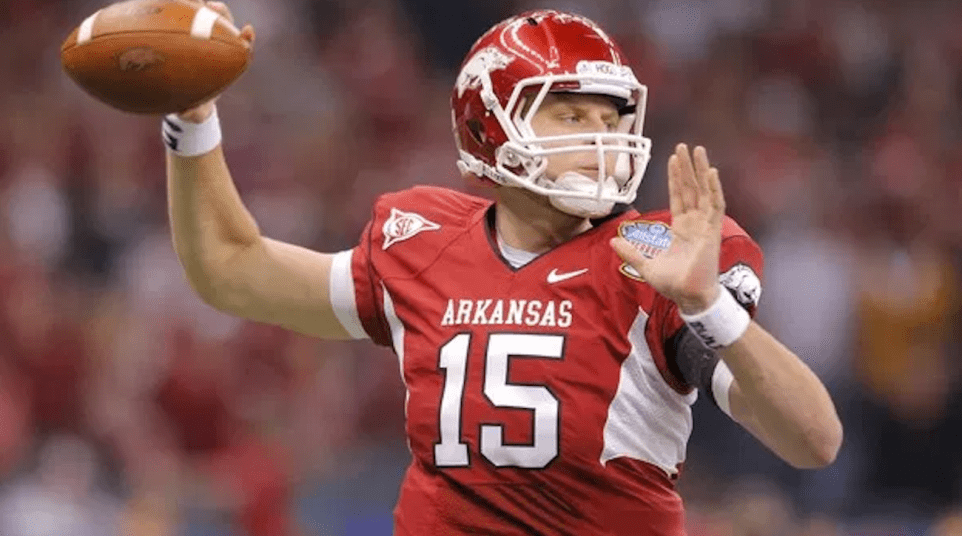
Hayes: Ryan Mallett's tragic end stirs memories of the free-wheeling SEC era he started
One by one they remembered Ryan Mallett, thoughtful yet sobering statements to a life lost too soon.
Bill Belichick. Tom Brady. JJ Watt. The Patriots. The NFL.
I like to think of the player I first met in 2009 at Arkansas, when writing a feature on a new trend in college football: transfer quarterbacks.
Who could’ve known Mallett, the first true elite quarterback transfer of the millennium, would begin a trend that would become the fabric of the SEC’s football dominance — and in the process force all college coaches to rethink the most important position on the field.
Before Cam Newton and Nick Marshall. Before Jake Coker and before Joe Burrow, there was Mallett.
The No.1 quarterback recruit in 2007, a brilliant flash for 2 seasons at Arkansas and a 7-year NFL veteran, Mallett, 35, drowned Tuesday while swimming at a Florida beach.
He leaves a legacy in the SEC and college football that can be traced to 1 critical decision early in his career. A decision that helped change the course of quarterbacks in college football over the last 2 decades.
Mallett signed with Michigan and coach Lloyd Carr, was the primary backup to Chad Henne and was set up to start in 2008. Then Carr retired. Then Michigan hired Rich Rodriguez.
At 6-5, 235 pounds, Mallett was a prototypical NFL quarterback, and Rodriguez’s quarterbacks ran the zone read option and focused more on the run than the pass.
So Mallet transferred to Arkansas to play for new coach Bobby Petrino, but per NCAA rules, lost a season of eligibility and didn’t play until 2009. That’s where this story begins.
There had been other quarterbacks in the history of college football who transferred and had success. But this move was unique.
This was the No.1 quarterback recruit from the previous season — in a time when high school recruiting had become a year-round obsession for coaches and fans — leaving because he didn’t fit the offense. Not because he wasn’t playing.
Mallett made an immediate impact at Arkansas, which began the 2009 season with games against Georgia and Alabama — where Mallet threw for 568 yards and 6 TDs. Arkansas had never seen anything like it, and the SEC hadn’t seen this type of passing prowess since Steve Spurrier’s quarterbacks at Florida in the 1990s.
Mallett threw 4 TDs the next week in a win over Texas A&M, and 2 more in a win over ranked Auburn. It was then that my editor told me to head to Fayetteville — because next up was a game at defending national champion Florida.
That Florida game was a defining moment for Mallett. The Hogs lost by 3 on a last-second field goal, but Mallett competed and battled and had double-digit underdog Arkansas in position to pull off the upset of the young season.
He outplayed the No.1 QB recruit from 2006, Tim Tebow.
Mallett threw for 242 yards and 1 TD against an elite defense, and but for a couple of questionable officiating calls — 1 that the SEC later admitted was wrong — the Hogs could’ve walked away with a their first signature win under Petrino.
After the game, in a postgame interview, Petrino made it clear: “(Mallett) played his a— off and deserved better. We’ll get better because he’ll get better.”
Arkansas won 15 of its next 20 games with Mallett before he left for the NFL, including 10 games in 2010. He had a TD/INT ratio of 62/19, threw for 7,496 yards in 2 seasons, and led the Hogs to the Sugar Bowl in his final season.
He didn’t win an SEC Championship, but his move to Arkansas in 2008 paved the way for a handful of critical transfers who left their original schools and won SEC championships.
Newton (2010) and Marshall (2013) left their first schools because of off-field issues. Coker (2015) and Burrow (2019) left because they couldn’t get on the field.
Three of the 4 (Newton, Coker, Burrow) won national titles, the other (Marshall) came within a final, last-second drive from winning it all.
Newton and Burrow had the 2 greatest seasons for a quarterback in the modern era of college football. Coker managed the Alabama offense for 12 games — then was the best player on the field in the final 3.
The flood of quarterback transfers began soon after, with Baker Mayfield, Kyler Murray and Jalen Hurts at the top of the list. The position is now — in the era of free player movement — full of turnover every season.
There were more than 190 quarterbacks in the transfer portal this past offseason, and more than half still haven’t signed with another school.
Elite recruits or 3-star projects, it doesn’t matter. If you’re a quarterback and you’re not playing, you’re more than likely moving on.
And it all goes back to the decision made by the No.1 quarterback recruit of 2007.
Two years later, and after the game in Gainesville, Mallett was preparing to get on a bus to drive to the airport and fly back to Fayetteville. He was physically and emotionally drained, and full of cuts and bruises from a brutal 3 hours dodging the Florida defense.
He was agitated by the officiating, and mad at himself for missing a wide open TD throw that could’ve made a difference.
I asked him if his success would lead to other big name quarterbacks leaving major programs.
“This kind of opportunity, these games, makes it all worth it,” he said.
Rest in peace, Ryan. Your legacy is secure.
